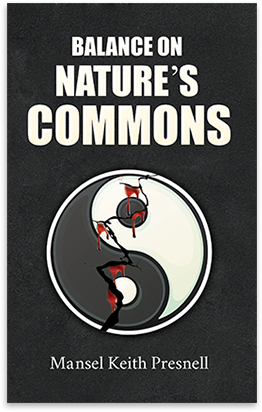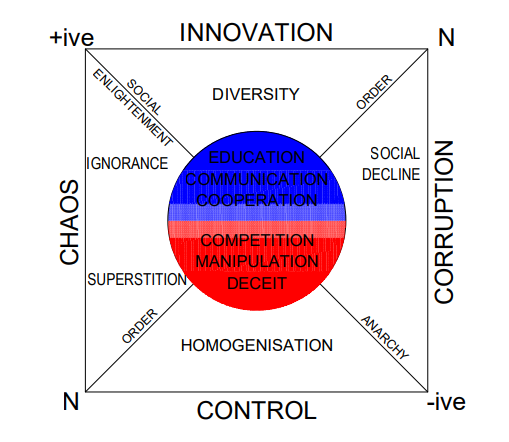
THE IMPORTANCE OF BALANCE
A balanced environment is a productive environment. The debate about the impact that our species is having on environmental balance incorporates science, politics, guesswork and lies. Mankind’s many technological advances are at risk of being lost for want of balance. Should we as a species intend to preserve opportunities for future generations, we will need to exhibit a functional appreciation of the mechanics involved.
Balance buys the time needed for order to emerge from chaos. Order then fathers synergies, either as natural evolution or as conscious behaviour. Wikipedia describes balance in biomechanics as an ability to maintain the line of gravity (vertical line from centre of mass) of a body within the base of support with minimal postural sway.
Natural Balance contains a degree of postural sway that enables the environment to absorb change without undue disturbance. The challenge for contemporary society is to recognise the limits imposed by ‘postural sway’, and to adjust its behaviour accordingly. The graph below is the social equivalent of the economist’s ‘Supply and Demand’ graph. It incorporates the behavioural flux’s that underpin our civilisation.

The circle at the centre represents the postural sway available for social balance to remain stable. Any distortion at the circumference of the circle introduces a change that risks destabilising social balance. Should the distortion be in the direction of the positive pole, risk will be accompanied by opportunity, with the possibility of restructuring social order in a positive way. Should the distortion extend towards the negative pole then we can expect any changes to be socially regressive.
The extent of social unrest globally is a measure of the damage that our species is doing to environmental balance. To reverse that trend, humanity will need to match its focus on commerce with equivalent attention to spiritual comprehension. It will need to resurrect the use of ‘common sense’ as a filter for actions taken, and that might well involve engaging artificial intelligence to audit human behaviour. We must learn to put cooperation before competition, treat education as being something distinct from manipulation, and minimise deceitful communication.
When an individual’s voice is discounted, when they are deprived of access to a functional education, or when they are left without a challenge, then the outcome for their community is going to be sub-optimal. They become grist for anti-social activities. The holy grail for humanity is to coordinate the potential of every individual to be productive and creative. That will involve universal access to education, and a population size regulated to match the demands of evolution.
From diversity comes resilience. Balance is a feature of small communities where everybody knows everybody and natural accountability sponsors equity. Members generally share social responsibilities. However, since the industrial revolution, the bulk of the rural population has emigrated to large cities where the needs of the community are met by the ‘system’. The homogenised service comes at a cost, which not all members of the community either want or can afford.
Modern mega-communities have become ‘commercial operations’ at the expense of both cultural and species diversity. Their operation discounts equity and integrity, replacing them with a suite of marketing strategies that serve to channel the bulk of the benefits from environmental plunder and the efforts of the majority, into the coffers of a minority.
Urbanisation of the workforce is turning out to be an expensive anachronism. Not only is it a major contributor to environmental degradation, but as community size increases, so does the social cost, and functionality of the infrastructure needed to maintain it. Transport systems fail to meet demand efficiently. The quality of social services such as education, public health, and welfare drops. Dissatisfaction with the system generates competitive, selfish and aggressive behaviour that is difficult to address. There are many negatives associated with an urban lifestyle. One could well ask why we persist.
A community in balance would feature knowledge-sharing, teamwork and equity. Managed by DNA, our nervous system is a classic model for social equity. It starts with nerve endings connected to the brain. Providing the signals sent to the brain come from a specific location, the brain can initiate a logical response. The system works well for most of us, and there is no reason why it wouldn’t work well for a community.
If we adopted that model, individuals would become the equivalent of nerve endings. Transmission of data from eight billion individuals to a central processing unit with the capability of collating, analysing and then applying the information expeditiously, would require society to be re-modelled with the help of artificial intelligence.
Take a community of fifty to a few thousand people occupying an area of land of sufficient size to support the community indefinitely. Each community enjoys local autonomy but is inspired by the ease of contributing their knowledge; via an artificial intelligence, data management facility or node; to assist future generations. Fifty to a few thousand nodes are connected to a regional data management facility. Fifty regional intelligence nodes connected to a national node, and so on, eventually create a global data repository that is directly responsive to ‘grassroots’ stimuli. Conversely, every village node would have direct access to a global perspective of health, telecommunication services, education, and product interface standards, along with the full range of innovative possibilities. In effect, Artificial intelligence would provide village DNA. Each village is unique, and each person is unique.
Technology is changing the way we do things. Instead of mega-industries, new microindustrial technologies that meet the needs of a small community should become the norm. Distributed energy systems, small-scale recycling systems, textile manufacturing, basic pharmaceutical capabilities that access local medicinal resources, etc., technologies that help the community to become self-sufficient. In total, they could provide opportunities for all individuals to contribute to social advancement based on their specific circumstances. Industrial monopolies would become less relevant, reducing the costs associated with resourcing and then distributing centralised production. The diversity engendered by the model would enhance humanity’s prospects for adapting to environmental change.
It is conceivable that we could rebalance the Earth’s productivity in a meaningful time frame, but already the damage bill is high, and time is running out. Judging by the extent of environmental destabilisation that has emerged over the last century, there is a sound case for assuming that many localities are already well past their natural carrying capacity. The human predicament is, that while restoring the environmental balances that best suit our species might be technically achievable, we lack a common will.
M.K.Presnell 2024
Post Views : 243